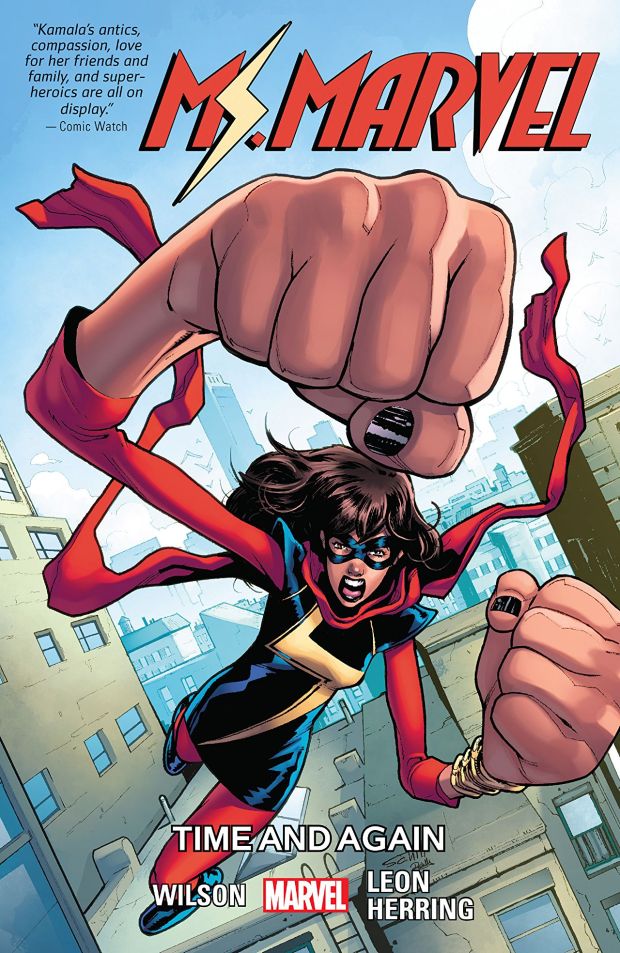by Jim Zub & Andy Suriano
Collects Samurai Jack #1-5
volume one
Samurai Jack was my favorite show growing up. The creativity of story, art and character defied the norms of most animation – from its borderless characters to its imaginative science fiction/fantasy premise, to minutes of silence at a time, to gorgeous backdrops, to the range of episodes. (I even took a break from comics to review the episodes of Jack’s final season which took twelve years to air.)
Zub and Suriano’s first volume of Samurai Jack feels like it was lifted from an original episode’s storyboards – the pacing, Jack’s dialogue, and the range of villains he meets along the way. The panels and colors are especially nostalgic (even with the character outlines) with some frames pulled directly from the show. There’s not much serenity, which can be hard to capture in panels, but the artistic tone is there – such as silent panels of Jack walking through different landscapes to communicate the length of his journey, a sequence used many times in the show.

Folks familiar with Jack will immediately understand the premise, and if not, a one-page summary paying homage to the animated show’s opening title will catch up new readers. As for the narrative, Jack’s quest to return to the past leads him to collect the threads of time, and he finds one in each issue. This structure also resonates with the show – more often than not, Jack sought portals and collected magical items to succeed in his journey, while helping villages and passersby along the way.
However, I’m not sure if this book is for adult fans who loved the show almost 20 years ago, (oh wow I’m going to pretend I didn’t write that,) or kids who are newcomers to Jack’s world who may have also seen the new final season. The villains are very cheesy, there’s unnecessary body humor, and the over exaggerated art often adds to the cheesiness instead of lifting up what made it unique in the first place. Many times it feel sloppy and unfinished rather than pushing the boundaries of creativity. (Aku was the most disappointing part of this, more on him later.) And yet, the book goes to great lengths to follow the pacing and feel of the animated show, sometimes too much – the ending is very disappointing and inherits the all or nothing aspect of the show and Jack’s mission.
A Samurai Jack book for young readers isn’t a worthless endeavor. It originally lived as a show that was meant for kids – and had quite a bit of silly humor. (All you need to say to a fan is “Jack and the Dragon” or “Jack in Wonderland” to get a lovely eye roll and accompanying groan in response) – I was one of those kids who simply loved it. And I completely accept that not all comics will be written with my age group in mind. But the comic book leans so far into that humor, it loses what made the show also accessible to adults, now the age group of folks who watched the series. (And I’m truly not sure if the comic is meant for kids who haven’t seen the show and how successful that model is.)
Tartakovsky created a fifth season with a more mature emotional tone (the artistic creativity in that season is also just stunning), but Zub and Suriano have completely abandoned both of those areas of growth in the Jack series. It’s very possible to cater to multiple age demographics in one story, but it just isn’t done here. And I don’t see any adult who hasn’t seen Samurai Jack having any desire to seek out the show after reading this comic book; it’s not a faithful portrayal of it.

On a positive note, the best issue by far has Jack finding what looks like an ancient Greek city, and its hero named Gloer the Great; it hit the dark emotional notes from the show perfectly. (Aesthetically, it was also very similar to the Jack and the Spartans episode.) But the rest was very repetitive, not to mention predictable as hell if you are a fan of the show – oh and we can’t forget how the only woman in the whole book is a self centered queen who uses her beauty to stay in power. YIKES.
Aku finally arrives in the final issue, and my biggest grievance is how he’s so messily drawn – Aku is not an easy character to draw, but his flaming eyebrows, horns and curved teeth, not to mention shapeshifting black body, allowed for so many visual and almost visceral opportunities in the show. They are completely missed here. The feeling of true evil, the wow factor of his demonic powers is totally gone, and instead the fifth issue feels completely rushed instead of a climax worth reading up to. For a book that seemed to be crafting an homage to the series, this move undermined all of that work almost completely.

While it was a nostalgic read to be sure, I’d much prefer a more grown up book for original fans that the show couldn’t do on Cartoon Network. There are commentaries about dictatorships, loneliness and mental health, and the environment that were finally touched on in the last season, but the creators were too focused on wrapping up the series to bring those out. Or maybe Zub and Suriano can continue this one and IDW can hire me to write the grown up series 😉 I did write Samurai Jack fanfiction back in the day…





